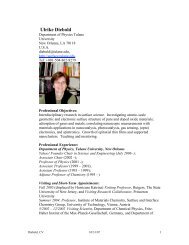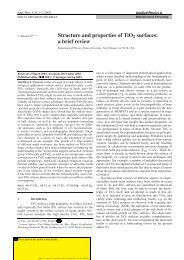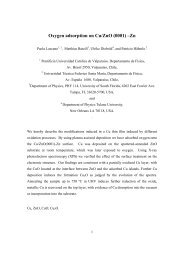The surface science of titanium dioxide - Niser
The surface science of titanium dioxide - Niser
The surface science of titanium dioxide - Niser
Create successful ePaper yourself
Turn your PDF publications into a flip-book with our unique Google optimized e-Paper software.
66 U. Diebold / Surface Science Reports 48 (2003) 53±229<br />
and, more recently, atomic force microscopy (AFM), studies have revealed the complexity <strong>of</strong> the<br />
seeminglysimple rutile (1 1 0) <strong>surface</strong>, hence the section on TiO 2 (1 1 0) commences with a<br />
recommendation on the best wayto prepare this <strong>surface</strong>. <strong>The</strong> two other low-index planes, rutile (1 0 0)<br />
and (0 0 1) are described in Sections 2.3 and 2.4, respectively. Until fairly recently the (1 3)<br />
reconstruction <strong>of</strong> the rutile (1 0 0) seemed well understood, but inconsistencies in theoretical<br />
calculations as well as new interpretations <strong>of</strong> X-raydiffraction data show that a closer look on the<br />
structure <strong>of</strong> this phase maybe needed (Section 2.3.2.2). New developments on structural investigations<br />
<strong>of</strong> anatase samples are included at the end.<br />
2.1. Bulk structure<br />
Titanium <strong>dioxide</strong> crystallizes in three major different structures; rutile (tetragonal, D 14<br />
4h -P4 2/mnm,<br />
a ˆ b ˆ 4:584 AÊ , c ˆ 2:953 AÊ [49]), anatase (tetragonal, D 19<br />
4h -I4 1/amd, a ˆ b ˆ 3:782 AÊ , c ˆ 9:502 AÊ )<br />
and brookite (rhombohedrical, D 15<br />
2h -Pbca, a ˆ 5:436 A Ê , b ˆ 9:166 AÊ , c ˆ 5:135 AÊ ) [65]. (Other<br />
structures exist as well, for example, cotunnite TiO 2 has been synthesized at high pressures and is one<br />
<strong>of</strong> the hardest polycrystalline materials known [66].) However, onlyrutile and anatase playanyrole in<br />
the applications <strong>of</strong> TiO 2 and are <strong>of</strong> anyinterest here as theyhave been studied with <strong>surface</strong> <strong>science</strong><br />
techniques. <strong>The</strong>ir unit cells are shown in Fig. 2. In both structures, the basic building block consists <strong>of</strong> a<br />
<strong>titanium</strong> atom surrounded bysix oxygen atoms in a more or less distorted octahedral con®guration. In<br />
each structure, the two bonds between the <strong>titanium</strong> and the oxygen atoms at the aspices <strong>of</strong> the<br />
octahedron are slightlylonger. A sizable deviation from a 908 bond angle is observed in anatase. In<br />
rutile, neighboring octahedra share one corner along h1 10iÐtype directions, and are stacked with<br />
their long axis alternating by908 (see Fig. 2 as well as Fig. 6). In anatase the corner-sharing octahedra<br />
form (0 0 1) planes. <strong>The</strong>yare connected with their edges with the plane <strong>of</strong> octahedra below. In all three<br />
TiO 2 structures, the stacking <strong>of</strong> the octahedra results in threefold coordinated oxygen atoms.<br />
Rutile TiO 2 single crystals are widely available. <strong>The</strong>y can be bought in cut and polished form from<br />
companies such as Commercial Crystal Laboratories, USA; Kelpin Kristallhandel, Germany;<br />
Goodfellow, UK; Earth Jewelry, Japan and many others. A very small roughness is achieved by<br />
grinding the sample, and then polishing the <strong>surface</strong> for manyhours with a chemo-mechanical treatment.<br />
This is also referred to as epitaxial polish. Practical aspects <strong>of</strong> <strong>surface</strong> preparation and handling are<br />
discussed in [67].<br />
Ramamoorthyand Vanderbilt [68] calculated the total energy<strong>of</strong> periodic TiO 2 slabs using a selfconsistent<br />
ab initio method. <strong>The</strong> (1 1 0) <strong>surface</strong> has the lowest <strong>surface</strong> energy, and the (0 0 1) <strong>surface</strong><br />
the highest. This is also expected from considerations <strong>of</strong> <strong>surface</strong> stability, based on electrostatic and<br />
dangling-bonds arguments discussed in Section 2.2.1.1. below. <strong>The</strong> thermodynamic stability <strong>of</strong> the<br />
(1 0 0) <strong>surface</strong> was also considered, and was found to be stable with respect to forming (1 1 0) facets.<br />
<strong>The</strong> (0 0 1) <strong>surface</strong> was almost unstable with respect to the formation <strong>of</strong> macroscopic (1 1) (0 1 1)<br />
facets. From the calculated energies a three-dimensional (3D) Wulff plot was constructed, see Fig. 3.<br />
<strong>The</strong> Wulff construction [69] gives the equilibrium crystal shape <strong>of</strong> a macroscopic crystal. For<br />
comparison with experimental crystal shapes one has to take into account that only four planes were<br />
considered and that the calculations are strictlyvalid onlyat zero temperature.<br />
<strong>The</strong> experimental results on the three low-index rutile <strong>surface</strong>s discussed below ®t rather well with<br />
the stabilityexpected from these calculations. For rutile, the (1 1 0), (0 0 1) and (1 0 0) <strong>surface</strong>s have<br />
been studied, with (1 1 0) being the most stable one. <strong>The</strong>se three <strong>surface</strong>s are discussed in this section.







